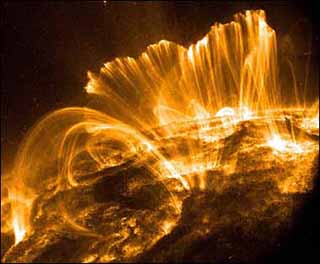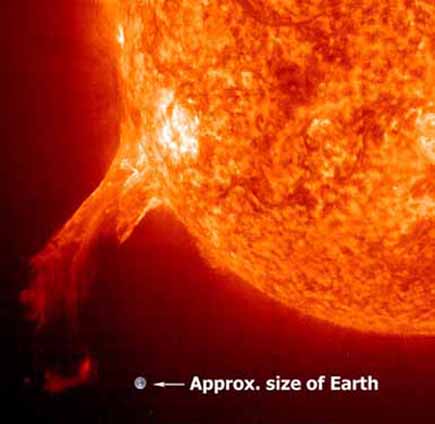Cosmic Rays Lab
Contents
Intro to Cosmic Rays


- Galactic Cosmic Rays: come from outside the solar system
- Anomalous Cosmic Rays: come from interstellar space at the edge of the heliopause
- Solar Energetic Particles: associated with solar flares
- September 27, 2004: If you've ever watched Star Trek, you know the importance of shields. When a star explodes or a Klingon death ray lances out of the darkness, the captain yells two words, "Shields up!", and all is well. Deflector shields: Don't leave home without one. The solar system, believe it or not, has got one.
- The solar system's deflector shield is a giant magnetic bubble called "the heliosphere." It's part of the sun's magnetic field. No one knows the precise dimensions of the heliosphere, but it's bigger than the orbit of Pluto. All nine planets are inside it.
- But the bubble isn't perfect. The fact is, "it's leaky," says space scientist Eberhard Moebius of the University of New Hampshire. "Some things do get through."
Take cosmic rays. They are fragments of atoms shattered and accelerated to light speed by supernova blasts. The heliosphere deflects about 90% of them; the rest, the most powerful 10%, penetrate the inner solar system.
- The bubble is even more vulnerable to particles with no electric charge. Magnetic fields can deflect charged particles like cosmic rays, but not neutral atoms and molecules or bits of dust and rock. The bubble is an open door to these.
Cosmic Rays Lab

Periodicity
When observing this graph, we noted that the proton speed appears to be the most periodic graph. While there is some variation in the magnitude of proton speed, the general magnitude is fairly similar. Proton density is also periodic with regards to the frequency of occurrence of the density spikes; however, the magnitude of the spikes varies. The helium/hydrogen ratio seems more irregular than the other two, though some periodic pattern could be extrapolated. However, magnitude differences in this ratio are drastic. Interestingly, the periodicity of all three functions appears to correlate—when a spike is observed in one data set, the other two also contain a spike.
Magnitude
While proton speed has a relatively stable magnitude (looking at the entire year, this is made blatantly obvious). The helium/hydrogen ratio also has a relatively constant magnitude, though there are occasional spikes in the data. The magnitude of proton density, however, remains irregular and unpredictable.
Weather On Earth (Day 265)

September 24, 2006 (day 265): geomagnetic storms raged over Canada and the Northern US. A glowing green aurora was spotted in Montana.
Radio Jove Data Archive



The Radio Jove data archive indicates a solar burst on the 22nd of September (which was close to the point at which the highest spike in proton density occurred). The recorded data seems slightly spikier than the curved graph (at the point of the solar burst) provided on the website. However, the “spikiness” of the radio signal may be due to the scaling of the x-axis. The sample data of a solar burst provided by the Radio Jove data archive illustrates the curvature of the solar burst over a time frame of approximately 30 seconds. The data from September 22, however, covers more than three minutes, thus rendering the graph markedly pointed (rather than gently sloping). The shape of the solar burst remains similar in all three of the gathered data sets—there was an initial peak about 2/5 the height of the full peak.

The ACE satellite, launched in 1997 by NASA, moves around the Lagrange point where the gravity of the sun balances that of the earth. According to the National Institute of Information and Communications Technology, the solar wind that passes the Lagrange point reaches the earth in about 1 hour. This statement can be used to confirm the assumed speed of solar particles (400 km/sec). The Lagrange point occurs approximately 1,500,000 km away from the earth. Thus, dividing this distance by the speed of the solar wind provides the time in seconds for the solar wind to reach the earth (3750 seconds). Dividing this time by 3600 provides the time in hours for the solar wind to reach the earth—1.04 hours, thus verifying that the speed of the solar wind matches the 400 km/sec approximation.
The calculated time for the solar particles to travel at 400 km/sec to the ACE satellite and through radio signals to earth is approximately 4.28 days. The calculated time for the solar particles to reach Jupiter and send a radio signal back to Earth is approximately 22.55 days. This calculation indicates that the data gathered from the Radio Jove data archive actually corresponds to a previous solar burst (approximately 3 weeks earlier), and not the solar burst we observed from the ACE satellite data.
Back to Stanford